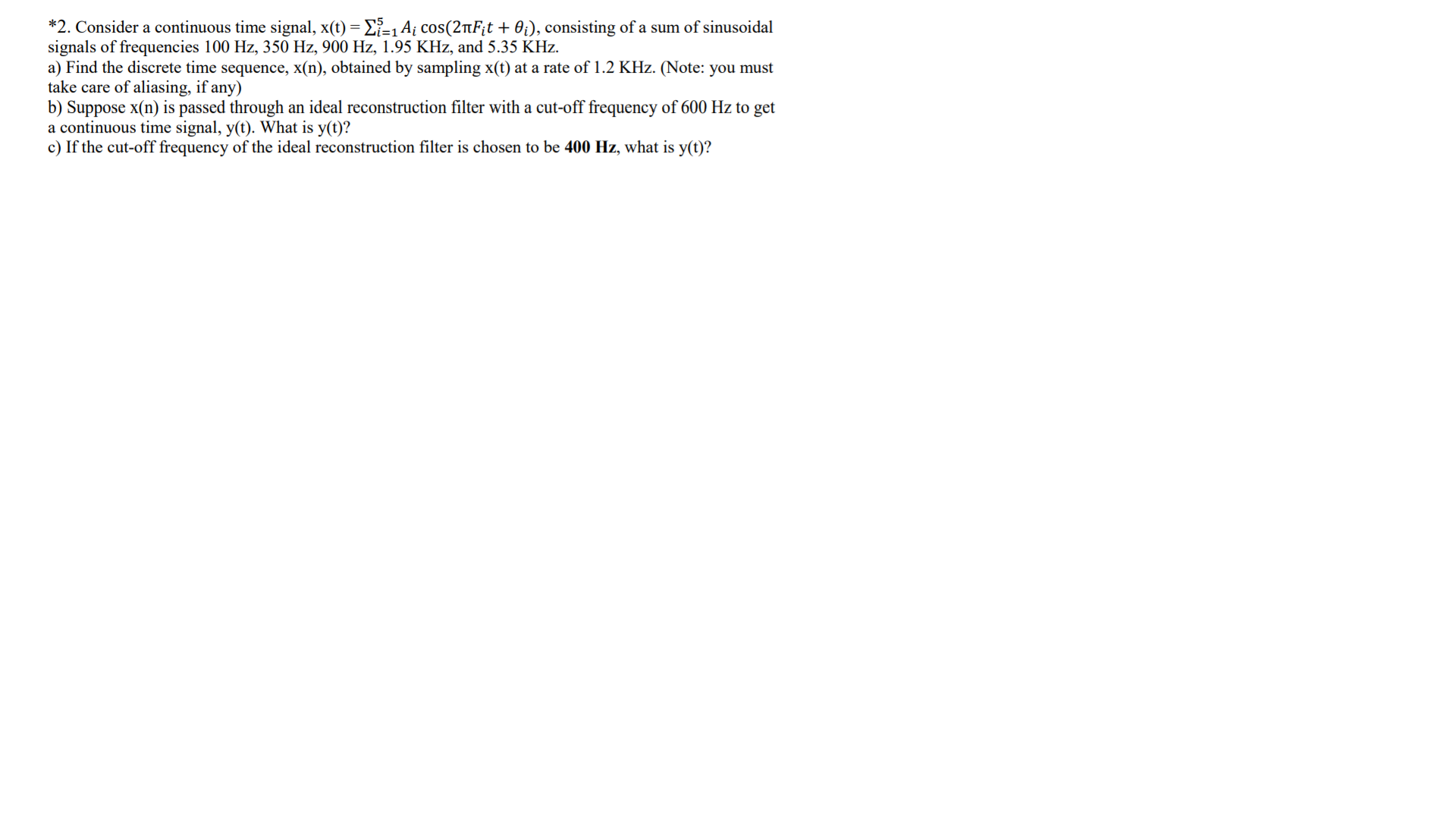*2. Consider a continuous time signal, x(t) = E}=1 A¡ cos(2nF¡t + 0¡), consisting of a sum of sinusoidal signals of frequencies 100 Hz, 350 Hz, 900 Hz, 1.95 KHz, and 5.35 KHz. a) Find the discrete time sequence, x(n), obtained by sampling x(t) at a rate of 1.2 KHz. (Note: you must take care of aliasing, if any) b) Suppose x(n) is passed through an ideal reconstruction filter with a cut-off frequency of 600 Hz to get a continuous time signal, y(t). What is y(t)? c) If the cut-off frequency of the ideal reconstruction filter is chosen to be 400 Hz, what is y(t)?
*2. Consider a continuous time signal, x(t) = E}=1 A¡ cos(2nF¡t + 0¡), consisting of a sum of sinusoidal signals of frequencies 100 Hz, 350 Hz, 900 Hz, 1.95 KHz, and 5.35 KHz. a) Find the discrete time sequence, x(n), obtained by sampling x(t) at a rate of 1.2 KHz. (Note: you must take care of aliasing, if any) b) Suppose x(n) is passed through an ideal reconstruction filter with a cut-off frequency of 600 Hz to get a continuous time signal, y(t). What is y(t)? c) If the cut-off frequency of the ideal reconstruction filter is chosen to be 400 Hz, what is y(t)?
Introductory Circuit Analysis (13th Edition)
13th Edition
ISBN:9780133923605
Author:Robert L. Boylestad
Publisher:Robert L. Boylestad
Chapter1: Introduction
Section: Chapter Questions
Problem 1P: Visit your local library (at school or home) and describe the extent to which it provides literature...
Related questions
Question

Transcribed Image Text:*2. Consider a continuous time signal, x(t) = E}=1 A¡ cos(2nF¡t + 0¡), consisting of a sum of sinusoidal
signals of frequencies 100 Hz, 350 Hz, 900 Hz, 1.95 KHz, and 5.35 KHz.
a) Find the discrete time sequence, x(n), obtained by sampling x(t) at a rate of 1.2 KHz. (Note: you must
take care of aliasing, if any)
b) Suppose x(n) is passed through an ideal reconstruction filter with a cut-off frequency of 600 Hz to get
a continuous time signal, y(t). What is y(t)?
c) If the cut-off frequency of the ideal reconstruction filter is chosen to be 400 Hz, what is y(t)?
Expert Solution
This question has been solved!
Explore an expertly crafted, step-by-step solution for a thorough understanding of key concepts.
This is a popular solution!
Trending now
This is a popular solution!
Step by step
Solved in 2 steps with 5 images

Knowledge Booster
Learn more about
Need a deep-dive on the concept behind this application? Look no further. Learn more about this topic, electrical-engineering and related others by exploring similar questions and additional content below.Recommended textbooks for you

Introductory Circuit Analysis (13th Edition)
Electrical Engineering
ISBN:
9780133923605
Author:
Robert L. Boylestad
Publisher:
PEARSON

Delmar's Standard Textbook Of Electricity
Electrical Engineering
ISBN:
9781337900348
Author:
Stephen L. Herman
Publisher:
Cengage Learning

Programmable Logic Controllers
Electrical Engineering
ISBN:
9780073373843
Author:
Frank D. Petruzella
Publisher:
McGraw-Hill Education

Introductory Circuit Analysis (13th Edition)
Electrical Engineering
ISBN:
9780133923605
Author:
Robert L. Boylestad
Publisher:
PEARSON

Delmar's Standard Textbook Of Electricity
Electrical Engineering
ISBN:
9781337900348
Author:
Stephen L. Herman
Publisher:
Cengage Learning

Programmable Logic Controllers
Electrical Engineering
ISBN:
9780073373843
Author:
Frank D. Petruzella
Publisher:
McGraw-Hill Education

Fundamentals of Electric Circuits
Electrical Engineering
ISBN:
9780078028229
Author:
Charles K Alexander, Matthew Sadiku
Publisher:
McGraw-Hill Education

Electric Circuits. (11th Edition)
Electrical Engineering
ISBN:
9780134746968
Author:
James W. Nilsson, Susan Riedel
Publisher:
PEARSON

Engineering Electromagnetics
Electrical Engineering
ISBN:
9780078028151
Author:
Hayt, William H. (william Hart), Jr, BUCK, John A.
Publisher:
Mcgraw-hill Education,